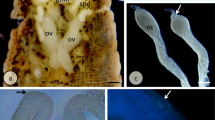Summary
On the growth of the imaginal ovary in connexion with the physogastric enlargement ofOdontotermes badius Haviland (Insecta, Isoptera).
The tubelike ovary ofOdontotermes badius is penetrated at full length by the oviduct into which approximately 3,000 ovarioles are discharging from all sides.
In the case of a swarming female only the anterior 5 to 7 ovarioles are sufficiently mature to ovulate a few days after dropping of the wings. The rest of the ovarioles are in very early stages of development and very short in length and it takes several years before all of the ovarioles become fully mature.
The imaginal development of the ovary proceeds as follows: The ovarioles lengthen and the distances between them become larger while the oviduct becomes longer and wider. When an ovariole reaches the first stage of maturation and gives off mature oocytes the lengthening of the ovariole is incomplete. There is a correlation between the growth of the ovary and the further lengthening of an ovariole. Also the lengthening, of the ovarioles is correlated with an increase in number of germarium-cells, in the number of oocytes of the growing stage and in the number of occytes which deposit yolk simultaneously. But there is no new formation of ovarioles during the whole imaginal life.
The development of the ovarioles is phased. Those at the anterior pole are starting first and consequently reaching the maximum length sooner than the ovarioles at the hind part of the ovary. All the ovarioles start to develop but some of them develop more slowly and reach the maximum length later.
Growth of the ovaries is made possible by the enlargement of the abdomen. In connexion with this enlargement there is growth of all abdominal organs. We must distinguish between growth by cell division alone (e.g. epidermis, connectives, midgut, heart tube), by widening of the epithelium cells predominantly (e.g. spermatheca, accessory glands) and by formation of new tissue (e.g. malpighian tubules).
Zusammenfassung
Das schlauchförmige Ovar vonOdontotermes badius wird in seiner ganzen Länge vom Ovidukt durchzogen, in den von allen Seiten annähernd 3 000 Ovariolen münden.
Bei einem schwärmenden Weibchen sind nur die ersten 5–7 Ovariolen in ihrer Entwicklung soweit fortgeschritten, dass wenige Tage nach dem Schwärmen und Abwerfen der Flügel Eier abgelegt werden können. Die übrigen Ovariolen sind noch in einem frühen Stadium der Entwicklung. Es dauert mehrere Jahre bis alle Ovariolen das Stadium der vollen Reife erreicht haben.
Zur imaginalen Entwicklung: Die Ovariolen nehmen an Länge zu. Die Zwischenräume zwischen ihnen werden grösser. Der Ovidukt wird länger und breiter. Die Längenzunahme der Ovariolen wird nicht beendet, sobald sie das Stadium der ersten Reife erreicht haben. Es besteht eine Beziehung zwischen dem Wachstum des Ovars und der weiteren Verlängerung der Ovariolen. Mit der Verlängerung der Ovariolen nehmen zu: Die Grösse des Germariums, die Zahl der Oocyten in der Wachstumsphase und die Zahl der zu gleicher Zeit Dotter-einbauenden Oocyten. Zu einer Neubildung von Ovariolen kommt es jedoch in der Imago nicht. Die Entwicklung setzt Ovarvorn ein. Die vorderen Ovariolen erreichen zuerst ihre maximale Länge. Die Ovariolen entwickeln sich jedoch nicht gleichmässig.
Im Zusammenhang mit dem Wachstum des Ovars nehmen alle Organe des Abdomens an Grösse zu. Dabei kann es sich um Zellteilungen, Vergrösserung von Zellen und um Neubildung von Organen handeln.
Im gleichaltrigen Männchen kommt es dagegen nur zu einer Hoden-Hypertrophie und zu einer Verlängerung des Mitteldarms.
Similar content being viewed by others
Literatur
Ahrens (W.), 1930. — Ueber die Körpergliederung, die Haut und die Tracheenorgane der Termitenkönigin.Jenaische Ztschr. Naturw.,64, p. 449–530.—Ahrens (W.), 1935. Monographie des weiblichen Geschlechtsapparates der Termiten (Nach Untersuchung anTermes redemanni).Jenaische Ztschr. Naturw,70, p. 223–302.
Bonneville (P.), 1936. — Recherches sur l'anatomie microscopique des Termites.Arvernia Biol.,15, p. 1–127.
Bordereau (C.), 1967. — Cuticule intersegmentaire des imagos des Termites supérieurs (Isoptera, Termitidae): Dimorphisme sexuel, ultrastructure, relation avec la physogastrie de la reine.C. R. Acad. Sc. Paris,265, (25), p. 1997–2000.—Bordereau (C.), 1968. Etude au microscope électronique à balayage des membranes intersegmentaires et pleurales chez les imagos des Termites supérieurs (Isoptera: Termitidae).C. R. Acad. Sc. Paris,267 (23), p. 1972–1975.
Bugnion (E.), Popoff (N.), 1912. — Anatomie de la reine et du roi-Termite (Odontotermes redemanni, obscuriceps et horni).Mém. Soc. Zool. France,25, p. 210–233.
Cmelik (S. H. W.), 1971. — Composition of the lipids from the gut of Termite queens.J. Insect. Physiol.,17, p. 1349–1358.
Gabe (M.), Noirot (C.), 1960. — Particularités histochimiques du tissu adipeux royal des Termites.Bull. Soc. Zool. France,85, p. 376–382.
Grassé (P. P.), 1949. — Ordre des Isoptères ou Termites, inTraité de Zoologie (P. P. Grassé, édit.), vol. IX, p. 408–544, Masson et Cie, Paris.
Holmgren (N.), 1909. — Termitenstudien. 1. Anatomische Untersuchungen. Kungl.Svenska Vet. Hand., Stockholm,44, p. 1–215.
Kistner (D. H.), 1969. — The Biology of Termitophiles. InBiology of Termites (K. Krishna und F. M. Weesner, édit.), vol. I, p. 525–557. Academic Press, New York.
Mukerji (D.), Raychaudhuri (S.), 1942. — The structure, function and origin of the exudate organs in the abdomen of the physogastric queen of the termiteTermes redemanni Wasmann.Indian J. Entomol.,4, p. 173–199.
Noirot-Timothée (C.), Noirot (C.), 1965. —L'intestin moyen chez la reine des Termites supérieures. Etude au microscope électronique.Ann. Sci. Nat. Zool. Biol. Animale (12),7, p. 185–206.
Truckenbrodt (W.), 1966. — Ovariolenverlängerung und Eiablage bei der TermiteKalotermes fiavicollis Fabr.Z. Morph. Öekol. Tiere,57, p. 274–294.
Weber (H.), 1954. —Grundriss der Insektenkunde. 3. Auflage, Gustav Fischer, Stuttgart.
Author information
Authors and Affiliations
Additional information
Herrn ProfessorWeidner, Hamburg, danke ich für die Artbestimmung; HerrnJ. Stein für die Ausführung der Zeichnungen.
Rights and permissions
About this article
Cite this article
Truckenbrodt, W. Ueber die imaginale Ovarvergrösserung im zusammenhang mit der Physogastrie beiOdontotermes badius Haviland (Insecta, Isoptera). Ins. Soc 20, 21–40 (1973). https://doi.org/10.1007/BF02223559
Issue Date:
DOI: https://doi.org/10.1007/BF02223559




